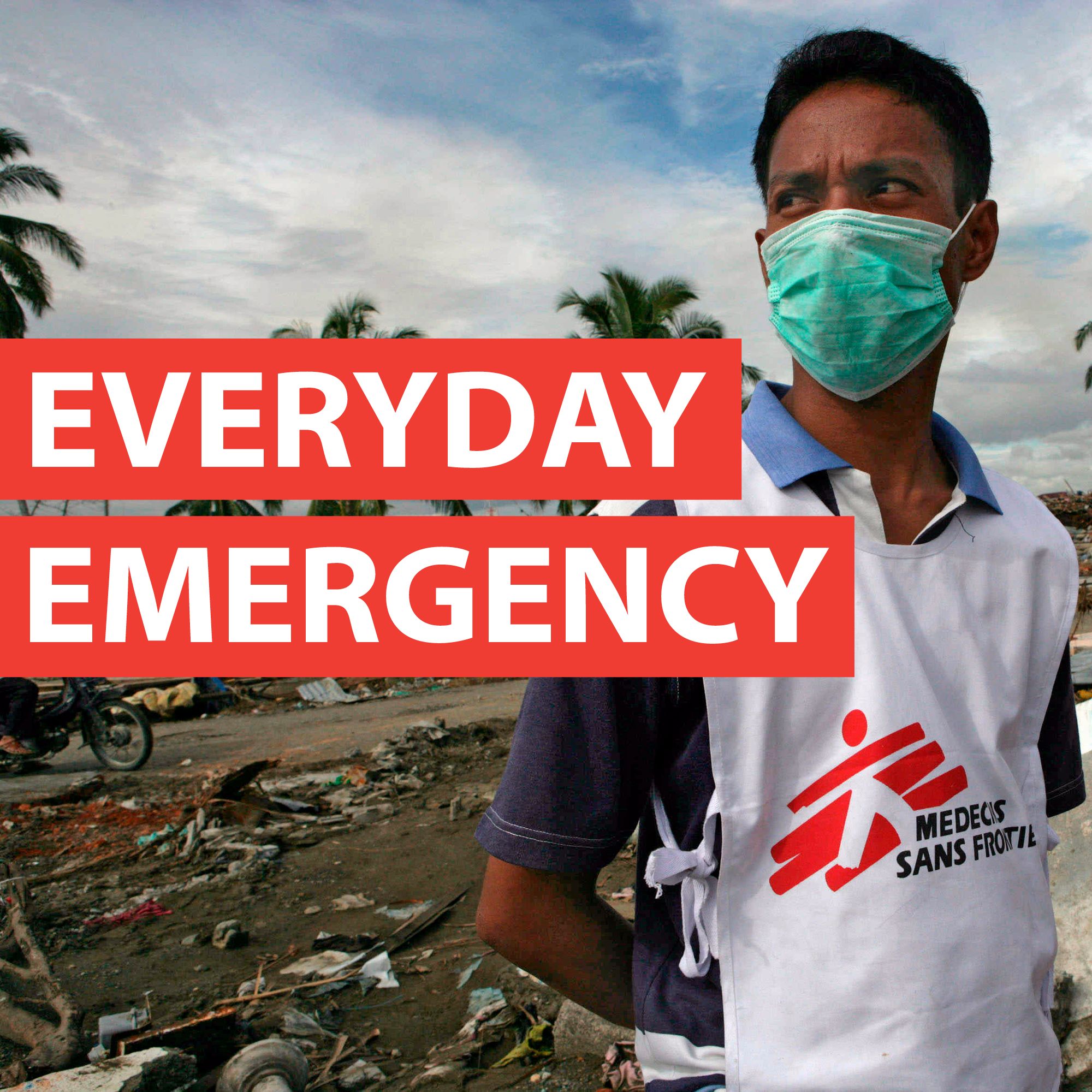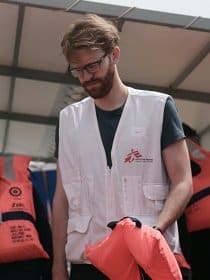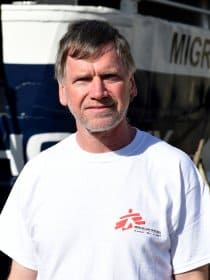We are currently facing the greatest displacement crisis since World War Two
Every year, thousands of people flee violence, insecurity, and persecution
They attempt a treacherous journey via north Africa and Turkey, in an attempt to cross the Mediterranean to reach Europe.
And every year, countless lives are lost on these journeys.
In 2016 alone, 5,096 people are thought to have died or gone missing during the crossing.
“A mass grave is being created in the Mediterranean Sea. Faced with thousands of desperate people fleeing wars and crises, Europe has closed its borders, forcing people in search of protection to risk their lives and die at sea. There is no more time to think, these lives must be saved now.”
If deemed necessary to save lives, MSF boats have approached the limit of international waters which are – by law – 12 nautical miles from the Libyan coast. Entering Libyan territorial waters is highly exceptional.
There were three occasions in 2016 when MSF – with the explicit authorisation of the relevant Libyan authorities – assisted in rescues 11.5 nautical miles from the coast.
We look out for boats in distress using binoculars and respond to directions from the MRCC in Rome in the event of an SOS call. Italian law states that not answering an SOS call from a boat in distress is an omission of rescue, subject to a penalty of one to five years of detention.
Non-governmental organisations account for a minority of search and rescue operations in the Central Mediterranean. EU assets, the Italian Coast Guard, commercial vessels and other actors are also involved in these operations, which are necessary to save lives.
International Maritime law states that all vessels have a legal obligation to assist boats in distress. If we weren’t there, other vessels, that do not specialise in search and rescue operations, would be asked to assist boats in distress.
 All three boats actively searched for boats in distress in international waters north of Libya.
Between late April, when the first boat, Dignity I, was launched, and the end of the year, teams rescued 21,603 refugees, asylum seekers and migrants and assisted 8,969 more in over 200 operations.
Medical teams onboard treated violence-related injuries linked to detention, torture and other ill-treatment, including sexual violence, in Libya.
Medics treated skin diseases, dehydration, hypothermia, scabies and serious injuries like chemical burns caused by fuel mixing with sea water in the boat.
Pregnant women were cared for by midwives onboard and several babies were born safely at sea. Lifesaving emergency care was also provided in emergency rooms on the ships or through medical evacuations, when needed.
People continued to try to cross the Mediterranean even as winter approached. From October onwards, MSF in collaboration with SOS MEDITERRANEE, ran the only NGO boat continuously carrying out search and rescue in this stretch of sea.
All three boats actively searched for boats in distress in international waters north of Libya.
Between late April, when the first boat, Dignity I, was launched, and the end of the year, teams rescued 21,603 refugees, asylum seekers and migrants and assisted 8,969 more in over 200 operations.
Medical teams onboard treated violence-related injuries linked to detention, torture and other ill-treatment, including sexual violence, in Libya.
Medics treated skin diseases, dehydration, hypothermia, scabies and serious injuries like chemical burns caused by fuel mixing with sea water in the boat.
Pregnant women were cared for by midwives onboard and several babies were born safely at sea. Lifesaving emergency care was also provided in emergency rooms on the ships or through medical evacuations, when needed.
People continued to try to cross the Mediterranean even as winter approached. From October onwards, MSF in collaboration with SOS MEDITERRANEE, ran the only NGO boat continuously carrying out search and rescue in this stretch of sea.
Loris de filippipresident of Médecins Sans Frontières/Doctors Without Borders (MSF) Italy
MSF search and rescue: the facts
MSF search and rescue operations are coordinated by the Maritime Rescue Coordination Center (MRCC) in Rome and comply with the law at all times. In line with international maritime law, all rescue operations at sea happen under the coordination of an MRCC (in this case the Italian Coast Guard Centre for the Coordination of Rescue on Sea). We patrol in international waters at around 25 nautical miles off the coast of Libya during the day, only moving closer to territorial waters if we have been instructed to do so by the MRCC or we become aware of a boat in distress. At night, we operate in international waters at 30 to 35 nautical miles from Libya.Who is rescued?
Refugees, migrants and asylum seekers are not interchangeable terms. The following is a brief explanation of the very different legal definitions:- A refugee is a person who has fled his or her country and cannot return because of a well-founded fear of persecution due to their race, religion, nationality, or membership of a particular social group. Refugee status is assessed by the United Nations High Commission for Refugees or a sympathetic state.
- An asylum-seeker is someone who says he or she is a refugee and is seeking asylum in another country, but whose claim has not yet been definitively evaluated.
- A migrant is someone who chooses to move in order to improve the future prospects of themselves and their families.
Where are the people rescued at sea taken?
Our primary aim was to prevent loss of life, not to provide transport. When a situation arose in which we had to intervene, we did so under the direction of the Maritime Rescue Coordination Centre in Rome. They also decided where those we rescued should disembark, as dictated by the laws of the sea. As a rule, those we rescued were taken either to reception centers in southern Italy (Sicily) or transferred from search and rescue boats to Italian coast guard vessels.A compromise to MSF’s neutrality?
We felt compelled first and foremost to assist people who were dying in the Mediterranean. We had the means and, for us, ignoring the problem was not an option.
Of course, we are aware that by doing this we are entering a very contentious political debate in Europe. But we believe that inaction cannot be justified on ideological grounds and that, in fact, as a medical organisation that takes its cues from medical ethics, we must take action. Find out more about our principles.MSF in the Mediterranean: 2016
In 2016, over three hundred thousand people fleeing wars, persecution, poverty and insecurity attempted to cross the Mediterranean in search of safety and refuge, according to UNHCR, the UN’s refugee agency.CENTRAL MEDITERRANEAN
It was the deadliest on record: 4,581 men, women and children died attempting to cross from North Africa to Europe. Of the 181,436 people who arrived safely in Italy after being rescued at sea, the vast majority had embarked in Libya. None would have made it to safety without rescue. During the year, our teams were on board three specially equipped SAR boats: Dignity I, a 50-metre vessel with the capacity to take 400 people on board, and a crew of 19 MSF staff; Bourbon Argos, a 68.8-metre vessel with the capacity for 700 people, and a crew of 11 MSF and 15 non-MSF staff; and Aquarius, a 77-metre vessel run in partnership with SOS MEDITERRANEE, with the capacity for 500 people.
Hear more stories from the Mediterranean on














